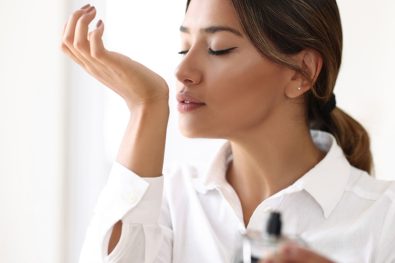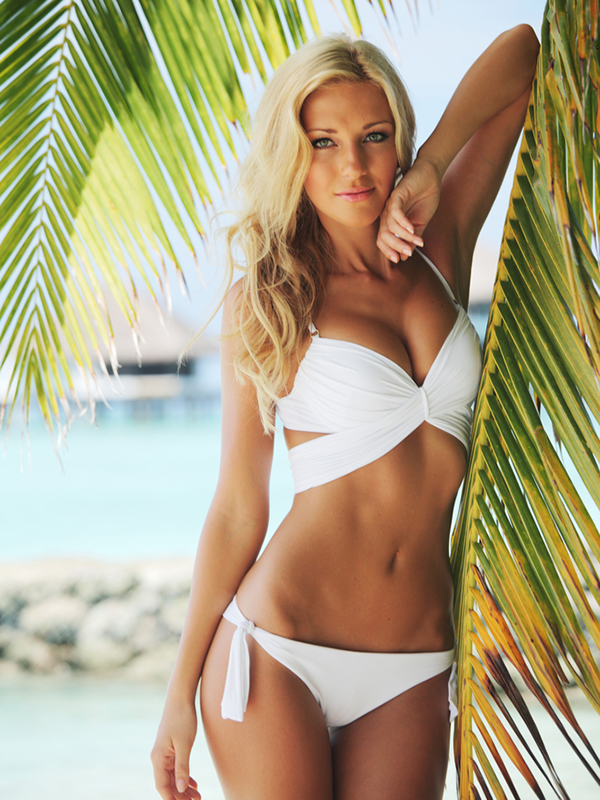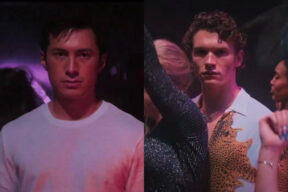Part of an ongoing series of 29Secrets stories, taking a deep dive into the history of legendary beauty products and iconic fashion moments…
By Christopher Turner
Illustration by Michael Hak
There are perfumes…and then there is Poison by Christian Dior – an audacious, intoxicating elixir that revolutionized the fragrance industry and scandalized the world with its unapologetic sensuality. Launched in 1985 by the French fashion house, Poison was more than just a perfume; it was a cultural phenomenon, a bold (and calculated) statement that purposely broke every rule of traditional perfumery.
With its slightly menacing name, Poison was nothing if not provocative when it was first released. Even the fairy-tale apple-meets-vintage-apothecary-bottle was designed to provoke an emotion, which was no coincidence. Everything – including the fragrance, the name and the bottle – was meticulously researched, because Dior desperately wanted a hit.
Created by perfumier Edouard Fléchier for Dior, Poison was a heady cocktail unlike any other, with conflicting notes that grabbed people’s attention and wouldn’t let go. So how did Poison by Christian Dior become so ubiquitous in the 1980s and ’90s? Here’s the history of the scent that changed perfumery forever.
Early history
The House of Dior was technically established on December 16, 1946, when French fashion designer Christian Dior opened the doors at his first shop at 30 Avenue Montaigne in Paris; however, the current Dior company celebrates 1947 as the opening year. Dior’s debut collection Corolle, which was presented on February 12, 1947, helped revolutionize the way women dressed and re-established Paris as the centre of the fashion world after World War II. The collection was so successful it was dubbed the “New Look,” a phrase that holds to this day.
Christian Dior’s first fragrance was Miss Dior, which was created by Paul Vacher to complement Dior’s first fashion collection. The floral fragrance, which was named after the designer’s sister – French resistance fighter Catherine Dior, familiarly known as Miss Dior – became available to the public shortly after the first collection was presented and was an instant bestseller in Paris.
The following year, the French fashion house created the Parfums Christian Dior company, directed by Serge Heftler-Louiche, a childhood friend of Christian Dior. This singular focus catapulted the Miss Dior fragrance around the world and led to the launch of other early Dior fragrances like Diorama (1949) and Diorissimo (1956).
Marc Bohan and the expansion of fragrances
When Christian Dior died of a sudden heart attack on October 24, 1957, the House of Dior and Parfums Christian Dior were thrown into chaos. To keep the label thriving, 21-year-old designer Yves Saint Laurent was promoted from being Dior’s first and only Head Assistant to become the Artistic Director for the French fashion house. However, Saint Laurent’s time in the role would be brief: he was abruptly fired from Dior shortly after being called upon to serve in the French Army during the Algerian War and was immediately replaced by French fashion designer Marc Bohan.
Bohan was Dior’s longest-serving creative director – almost 30 years, from 1961 to 1989. He initially took Dior in a more conservative direction, but managed to keep the label at the forefront of fashion, with Women’s Wear Daily claiming that Bohan had “rescued the firm.”
Bohan not only kept Dior producing wearable, elegant clothes, but also helped expand and revitalize the brand’s fragrance offerings. Parfums Christian Dior had taken on a distinctly old-fashioned aura throughout the years – Bohan helped launch new scents like Diorling (1963) and the first eau de toilette for men, Eau Sauvage (1966).
In 1968, Parfums Christian Dior was purchased by Moët-Hennessy (which would itself become LVMH). That company continued to work with Bohan to grow Dior’s beauty business with the launch of the first Christian Dior makeup line (1969), and women’s fragrances such as Diorella (1972), Dior-Dior (1976) and Dioressence (1979). With all that innovation, though, Miss Dior remained the brand’s biggest seller…that is, until the release of Poison.
“Poison is my potion”
The 1980s were a decade of indulgence, power dressing and unapologetic luxury. Everything was bigger, bolder and more extravagant – from the towering shoulder pads of Dynasty’s Joan Collins to the neon-drenched nights of Studio 54. The 1980s demanded boldness, and the era’s “more is more” attitude wasn’t just confined to fashion and lifestyle; it was also reflected in fragrance trends.
By the mid-1980s, light florals and delicate musk were being pushed aside in favour of statement-making scents. Perfumes weren’t just accessories: they were weapons of attraction, power and dominance. Dior recognized the shift and saw an opportunity to breathe a little life into their predictable fragrance offerings and create something bolder than anything before.
The truth is, Dior’s fragrance sales were down, and their scent offerings appeared to be losing their edge with consumers. 1976’s Dior-Dior had been an astounding commercial flop, and by the early ’80s the brand was struggling to compete in the marketplace. In 1984, Parfums Christian Dior reported that their worldwide sales were $152.7 million, and admitted that according to projections they would be unable to match that number the following year.
Maurice Roger, then CEO of Parfums Christian Dior, knew the fragrance offerings were flat, which is why he was strategizing for a hit. Roger envisioned a fragrance that would disrupt the industry, a scent so potent it would be impossible to ignore. He wanted something dramatic, extravagant and utterly unique – a perfume that would not only complement the decade’s excesses but define them. He also wanted something that could compete with Yves Saint Laurent’s top-selling fragrance, Opium, which had made its debut in 1977. According to trademark records, Roger actually licensed the name Poison in 1983 – two years before the scent would hit shelves. After all, the company wanted a name for the new fragrance that would generate massive publicity and, in turn, sales.
Roger commissioned several prominent perfumer-creators to create a new fragrance for Dior without providing them with any specific briefs, and tested approximately 800 different scents created by different independent perfumers. He eventually narrowed the submissions down to a selection he was happy with, then sent the testers to 10 of the most elegant women in Paris and asked them to rank the scents in order of preference. Interestingly, he chose the scent that was most disliked by the 10 ladies, demonstrating his willingness to break away from the traditional expectations of perfume.
That disliked perfume was created by Edouard Fléchier, a master perfumer at the prestigious Roure Bertrand Dupont perfumery school in Grasse, France, who was known for his daring compositions. Fléchier’s bombastic original creation was something that would ultimately leave a mark on everyone who encountered it. The fragrance was an intoxicating oriental floral unlike anything before it. It was rich, heady and unapologetically bold, blending fruit, spice, florals and deep, warm resins into a scent that felt almost forbidden. The fragrance wasn’t just another perfume – it was a sensory experience that seemed to linger long after its wearer had left the room.
The intensity of Poison was thanks to the unusual combination of scents. The scent’s top notes, which set the tone for the deep sensuality of the fragrance, include plum, coriander, anise and wild berries. Heart notes include tuberose, opoponax (sweet myrrh), cinnamon and incense. Rounding out the fragrance, the base notes include amber, musk, vanilla and sandalwood.
One of the notes that made the fragrance so unforgettable was tuberose. The tuberose in Fléchier’s original creation was particularly important – it wasn’t just a floral note, it was a declaration of seduction. (In Victorian times, young girls were forbidden from smelling tuberose at night, as its scent was believed to induce lustful dreams.) Tuberose has long been associated with sensuality, and in Fléchier’s fragrance, it was dialled up to an almost narcotic intensity.
Then there was the apple-inspired bottle that was designed to fit snugly in the palm of your hand. Perfume bottles in the 1980s were often ornate, but Dior’s Poison took things to another level with a bottle that made people think of Snow White and the poisoned apple, or Eve eating the apple from the tree of knowledge that poisoned her and Adam’s paradise. Veronique Monod, the designer behind its flacon, created a deep, hypnotic amethyst-coloured bottle that resembled a forbidden fruit. The curvaceous silhouette hinted at sensuality and indulgence, while the dark purple hue added mystery and danger. The aubergine-coloured bottle was topped with a clear, rounded cap, designed to resemble poison dripping from the top – a reminder that Poison wasn’t just a name, but a symbol of temptation.
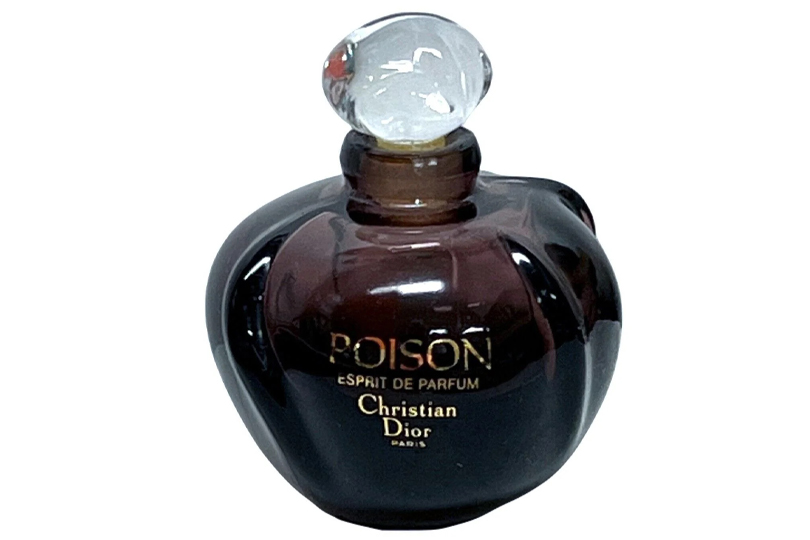
“Today you must cause women to pause to think about a fragrance,” said Susan Biehn, the then vice-president for advertising and creative services at Dior. “Obsession [Calvin Klein’s legendary scent that debuted in early 1985 to unprecedented success and sales] did it through its advertising. Dior will do it through the name and the scent itself.”
Biehn said the name was chosen because it is “revolutionary. It’s an adventurous name for an adventurous product. The name was definitely created to make you pause…. You gift the gift of ‘Poison’ to a perfume who lives that type of life.”
Too strong, too scandalous, too…poisonous?
When it was released in 1985, Poison was the first Dior perfume for women not to bear the name of its founder. Backed by an aggressive ad campaign, arguably inspired by Yves Saint Laurent’s Opium campaign, it also captured the public’s attention unlike any other fragrance in recent memory. To say that the public was tempted by the new fragrance is an understatement. The writer Paul Valéry once said that “perfume is the poison of the heart,” and this statement encapsulates the essence of Poison’s allure.
“Poison is an innovative and daring concept in women’s fragrances,” Biehn said at the time. “With so many new fragrances introduced each year, it is necessary to break through the noise surrounding these launches. We realize the name Poison is controversial, but we feel that as long as we handle every aspect of this fragrance nobly, there’s nothing to fear. Knowledgeable women are not afraid to try Dior’s Poison, because they know it is harmless and enticing to men.”
Dior initially spent $10 million in advertising for Poison, according to Bill Slater, then the senior vice president and general manager of Christian Dior in New York. “We were looking for something to shock the consumer,” Slater said in an interview. “The name is provocative and it stops the customer; each year it becomes more difficult to attract the public’s attention.”
“We’re hoping Poison is a springboard…and will help project us into greater volume,” added Slater. “You can’t tiptoe into this market; you have to march.”
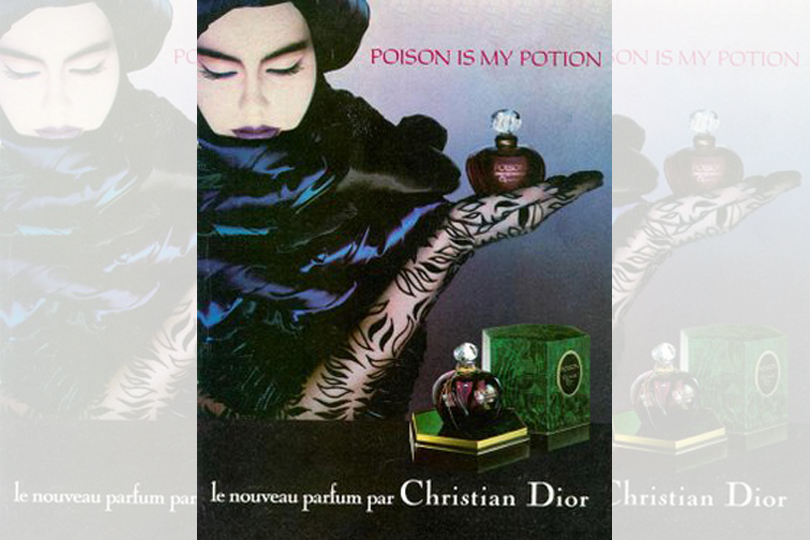
Poison represented a break with Dior’s past in more ways than one. It was considerably more expensive than most fragrances in the market at the time, and more expensive than the fragrances that had preceded it in the Dior line. The name, however, is what caused most of the early controversy.
“Finally, I realized you can afford to be a little controversial as long as your product is noble,” Roger told Women’s Wear Daily on June 21, 1985. “There are some 56 launches a year in Europe and some 35 in the U.S. That’s a lot of noise. You have to be exceptional to break through that wall. The name of a perfume is like the title of a book or the cover of a magazine – it has to be attractive and make a difference.”
From the moment it was released, Poison made waves. It was powerful, bold and unmistakable. Unlike modern perfumes, which tend to be more subtle and intimate, Poison was made to be noticed. It left a trail of scent wherever its wearers went, ensuring that they would be remembered. Some even claimed that certain restaurants and offices banned it because the scent was so overpowering.
“Heady, opulent and dark, Poison smelled slutty to me, like a girl in the drama club who slept with her boyfriends. My dislike was an anomaly, though, because my school’s hallways were flooded with the spicy, fruity, tuberose scent. Poison was, after all, the liquid embodiment of the ’80s,” fragrance expert Adriana Ermter told 29Secrets. “Bold and unapologetic, it wafted glamour, excess and ambition. Alongside cultural pop icons Madonna, Cyndi Lauper, Joan Collins and Princess Diana, it redefined femininity as powerful and confident, matching the decade’s power shift as women –– and their shoulder pads – claimed space in the boardroom.”
Countless critics called it “too much,” but that only added to its allure. “It won the Fragrance Foundation’s prestigious FiFi award [the perfume industry’s Oscars] too, in 1987,” says Ermter.
Of course, Poison was never meant to be a soft, demure fragrance – it was a perfume for women who commanded attention, who weren’t afraid to own their presence, who relished the power of scent.
Designer Halston, who thought that the name Opium was “kind of an odd social statement,” found the “naming of Poison to be an example of the true decadence of the fashion business. I think it’s just being done to create controversy. You can’t tell people to go in and ask for a bottle of Poison.”
The Poison legacy
Investing millions into the development of Poison worked for Dior. In early August 1985, just after its debut, the perfume had generated over $500,000 in sales, which was the best launch the company had ever had. And that was just the beginning. By October, the perfume was selling at the rate of one bottle every 50 seconds in the Galeries Lafayette in Paris, according to Jacques Perusse, the vice president of Prestilux, the Montreal company that represented Dior perfumes in Canada.
But the success was not without controversy. In 1986, the Daily Herald newspaper reported that Joan Kuffel, a nurse at River Trails Junior High School in Prospect, Illinois, had launched a national campaign urging Christian Dior to change the name of its perfume, and to persuade television stations to ban its suggestive commercials. “How can you call something poison? We have taught [children] what poison is. Now all of a sudden poison is supposed to be sprayed all over their mother.”
That campaign, and others like it, didn’t work, and Poison sales continued to skyrocket as the fragrance continued to be rolled out across the globe.
Due to its massive success, Poison eventually evolved into a fragrance dynasty, although it was 1994 before the brand followed up with Tendre Poison, also developed by Fléchier. More Poison-inspired scents followed throughout the years, most designed to appeal to a younger audience, including Hypnotic Poison (1998), Pure Poison (2004), Midnight Poison (2007) and Poison Girl (2016), with each reinterpretation carrying the same fearless DNA.
Those Poison flankers helped elevate Poison to icon status, something that probably couldn’t be replicated today.
“Today, I do not think it would be possible to go as far as we did with Poison,” Fléchier said in Michael Edwards’ 1996 book Perfume Legends: French Feminine Fragrances. “The new perfumes are tame by comparison. I think that’s why Poison has become a classic, because all the classics have an extreme dosage of some component. Consider Chanel no. 5 (1921), for example, with its overdose of aldehydes; Vent Vert (1947) with its jolt of galbanum; or Shalimar (1925) with its signature of ethyl vanillin.”
While many perfumes from the 1980s have faded into obscurity, Poison remains a cult favourite, with vintage bottles being highly sought after. Though today’s fragrance industry leans towards lighter, fresher scents, Poison is a reminder of a time when perfume was a statement, a declaration of identity and power.
“Poison was as transformational as it was unforgettable. And even though it’s been ages, when I close my eyes and concentrate, I can still smell it,” says Ermter. “Who knows, if it was still around, I might even like it.”
The formulation and bottle have, of course, been tweaked over the years. But it remains one of the most legendary and polarizing perfumes ever created, a testament to its fearless nature. Because Poison isn’t just a perfume – it’s a legend. And legends never fade.
![]()
Want more fragrance history roundups? You can read the story of Chanel No. 5, The World’s Most Popular Perfume, Le Labo’s Santal 33, Yves Saint Laurent’s Opium Perfume, and other stories from our The Story Of series right here.


